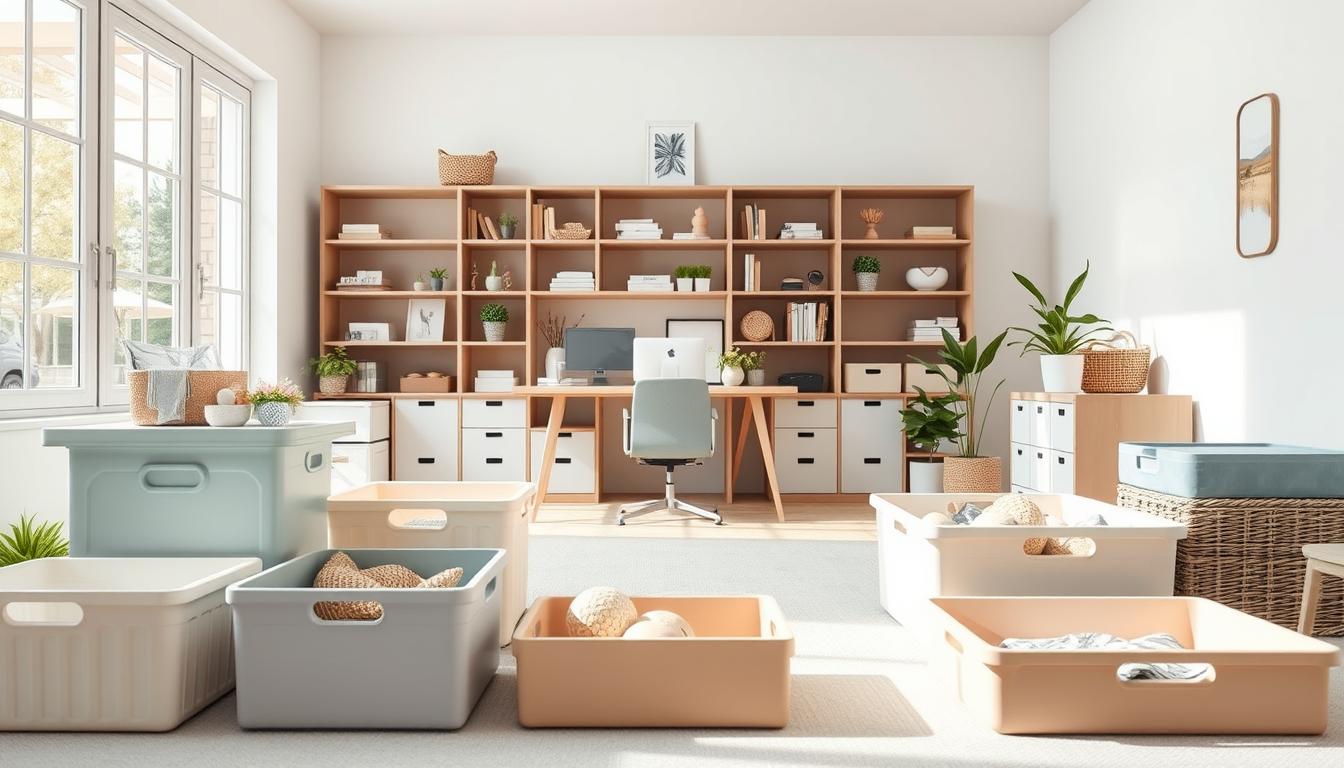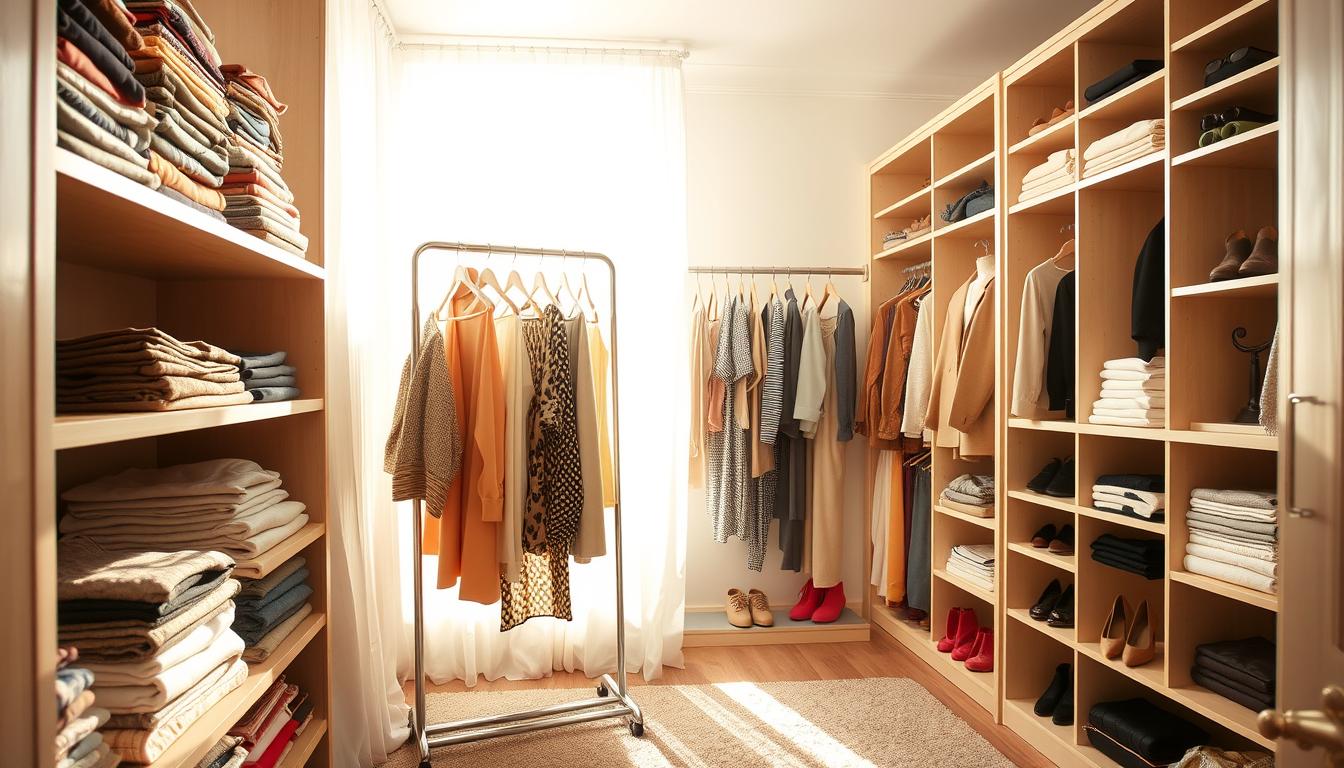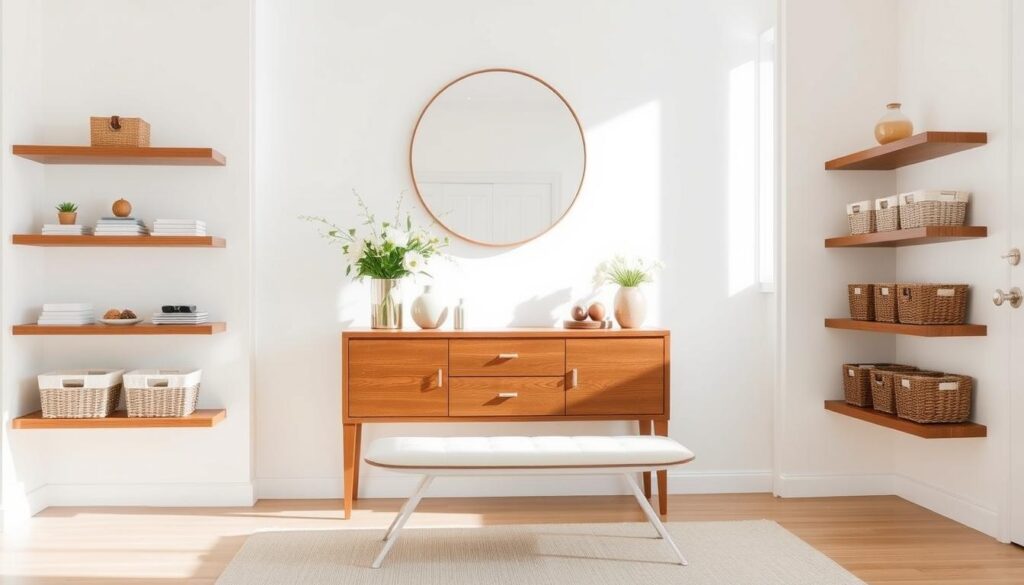Spring is the ideal time to transform chaos into calm. Start by decluttering before cleaning—70% of parents know kids’ rooms get messy fast, and 60% of families struggle with toy-stuffed playrooms. Spring organization tips don’t just tidy spaces—they reduce stress. Imagine a home where labeled bins cut cleanup time in half or multi-use furniture saves 40% of space. These home organization hacks turn overwhelming tasks into simple steps.
Begin with high-traffic zones. Clearing 12 items to toss, donate, or return follows the 12-12-12 rule. Involving kids in decluttering boosts long-term success, with 30% of parents seeing 50% better results. Every step, from swapping winter layers to floral spring decor, builds a space that nurtures well-being. Let’s start fresh.
Key Takeaways
- Declutter first: 70% of parents find kids’ rooms easier to manage after removing excess toys.
- Involving children increases organization success by 50%, reducing stress for 45% of declutterers.
- Multi-use furniture saves 40% space in kids’ rooms and simplifies daily routines.
- Use labeled bins—reducing cleanup time by 50%—to teach kids responsibility.
- Follow the 12-12-12 rule: 12 items to discard, donate, or return to their place.
Why Spring Cleaning Goes Beyond Just Dusting
Decluttering for spring isn’t just about scrubbing surfaces—it’s a fresh start organization opportunity to transform your home and mindset. Winter’s cozy routines often leave 20-30% more clutter, but studies show reducing this mess can cut stress by 30% and boost mood by 10%. Tidy spaces clear mental fog, letting you focus on what truly matters.
The Psychological Benefits of an Organized Space
A cluttered home mirrors a cluttered mind. Research links organized spaces to better sleep and 25% higher productivity. When 60% of people feel accomplished after decluttering, it’s clear the payoff extends beyond aesthetics. Imagine a room where every object serves a purpose—that’s the mental clarity you gain.
Setting Your Seasonal Organization Goals
- Identify zones needing attention (e.g., kitchen drawers, entryway piles)
- Use the 1-year rule: Keep only items used in the past year
- Start with high-impact areas like countertops or entryways
Households that donate 40% of decluttered items during spring also create space for new energy. Aim for 20 minutes daily to avoid overwhelm.
Creating a Personalized Spring Decluttering Schedule
Break tasks into 30-minute blocks. Pair with DIY solutions like vinegar-based cleaners. 80% of people stick to routines with a written plan. Try this:
Week 1: Tackle high-traffic areas
Week 2: Focus on storage solutions
Week 3: Refresh routines for long-term success
Decluttering for spring becomes a lifestyle shift when paired with fresh start organization. Every cleared surface is a step toward a home that fuels your best self.
Essential Spring Organization Tips for Every Room
Transform your home with spring organization tips that simplify spaces room by room. Start by targeting high-traffic zones where clutter accumulates fastest. Professional organizer Jenny Dietsch advises: “Empty and assess every area before restocking—it’s the secret to lasting order.”
“If you didn’t wear it all winter, it’s time to donate it.” —Jenny Dietsch
Implement these home organization hacks to create harmony in every corner:
- Living Areas: Use vertical shelving and clear bins to store seasonal decor. Stick to one theme or color palette to unify spaces.
- Bedrooms: Apply the “one in, one out” rule for wardrobe updates. Turn hangers to track usage over 3 months—items untouched get a new home.
- Kitchens: Group pantry items in labeled bins. Follow the “empty-assess-store” (E.A.S.Y.) process to declutter countertops.
- Entryways: Install hooks and baskets for keys, bags, and shoes. Keep outdoor and indoor decor separate to streamline access.

Pair these strategies with 30-minute daily sessions using the “52 Weeks Challenge” approach. Empty spaces fully before restocking, and use sealable tubs for off-season clothes. Label bins with erasable labels for flexibility. Studies show these steps reduce stress by up to 40% and boost productivity. By applying these spring organization tips, you’ll create a foundation for year-round calm. Start small—declutter one drawer at a time—and watch order grow room by room.
The KonMari Method: Finding Joy in Spring Decluttering
Decluttering for spring takes on new meaning with Marie Kondo’s minimalist home organizing philosophy. Since its Netflix debut in 2019, the KonMari Method has transformed how people approach tidying. Start by categorizing items across your entire home—not room by room—to see your full inventory. Professional organizer Steven Ip advises, “Categorizing reveals duplicates and frees mental space.”
Categorizing Items Instead of Rooms
Follow Kondo’s sequence: clothes, books, papers, komono (miscellaneous), and sentimental items. This order prevents room-by-room cleanup cycles. Ask: “Does this spark joy?” For example, sorting all t-shirts together helps identify which truly fit your lifestyle. Decluttering for spring this way ensures no space is overlooked.
The Art of Letting Go
“A cluttered space drains mental energy,” notes the Princeton Neuroscience Institute, linking chaos to reduced focus. When discarding, consider utility, cost, and sentimentality. If an item hasn’t been used in a year, it may belong in a donation bag. Goodwill saw a 66% donation surge in D.C. this year—proof of growing decluttering momentum.
Folding Techniques That Maximize Space
Kondo’s signature folding method turns drawers into tidy galleries. Follow these steps:
- Discard non-joyful items first.
- Align folded clothes vertically for visibility.
- Use drawer dividers ($29.99 for 8 pieces) to categorize socks and accessories.
Pair with vacuum-seal bags ($20 for 3) to store off-season items. The result? A wardrobe that reflects your true style—and space to breathe.
Tackling Seasonal Closet Organization
Transform your closet into a functional haven with seasonal closet organization strategies. Start by swapping winter layers for spring staples—think light fabrics and breathable materials. A study shows that organized spaces boost productivity by 25%, making this step vital for daily efficiency.

Winter-to-Spring Wardrobe Transition Strategies
- Evaluate: Donate items worn less than 3 times yearly. Keep only pieces that align with your style or needs.
- Preserve: Store winter coats in vacuum-sealed bags to free up 40% of closet space.
- Refresh: Rotate 10–12 core spring pieces to simplify outfit choices, reducing morning stress.
Space-Saving Hangers and Folding Methods
Maximize vertical space with slim velvet hangers—each saves 30% more room than traditional styles. Try the “Origami fold” for sweaters, stacking 7 chunky knits flat to avoid creases. Under-bed containers labeled with fabric tags keep off-season shoes or accessories accessible yet out of sight.
Create a Capsule Wardrobe for Simplified Living
A capsule wardrobe of 30–40 essential pieces cuts decision fatigue. Pair neutrals with 2–3 accent colors for effortless coordination. As minimalist expert Marie Kondo advises,
“Items should spark joy—and fit seamlessly into your lifestyle.”
Adopting these steps not only declutters your space but also saves $300+ annually by reducing redundant purchases. A clutter-free closet equals 15% faster morning routines—time better spent elsewhere!
Pantry Transformation: From Chaos to Culinary Haven
Imagine opening your pantry to find every ingredient at your fingertips—no more expired spices or lost snacks. Over 100% of those who tried pantry organization ideas report less chaos, and 85% say cooking becomes easier. Start by emptying shelves to assess inventory. Discard expired items and consolidate duplicates, as 40% of successful makeovers begin here.
- Zone Strategically: Group baking supplies, canned goods, and snacks into labeled zones. Place frequently used items at eye level to save time.
- Adopt Clear Containers: 25% of organizers use transparent jars for grains or snacks. IKEA shelving and Target baskets keep small pantries functional. Adjustable tracks maximize awkward spaces like under-stair layouts.
- Label Everything: Spend two hours labeling containers. Use bold text for zones like “Desserts” or “Grains.”
Home organization hacks like vertical shelves or stackable bins tackle cramped spaces. 30% of users prioritize aesthetics with decorative jars, but functionality comes first. Store bulk items in airtight containers to prevent waste; 50% donate unused goods. Keep only items that fit your storage—avoid buying mismatched containers.
“A well-organized pantry isn’t just functional—it’s a space that inspires cooking.”
Weekly checks ensure items don’t expire unnoticed. Use kitchen counters to display near-expiring goods. Invest under $100 with affordable tools from TJ Maxx or Pier 1. With mindful purchasing and clear zones, your pantry becomes a hub of creativity, not chaos. Let every shelf tell a story of simplicity and style.
Small Space Solutions: Making the Most of Limited Square Footage
Transform tight quarters into functional hubs with functional small space storage and space-saving storage strategies. Every inch counts when designing for urban homes or compact living areas—here’s how to rethink your setup.
Vertical Storage Ideas for Urban Homes
Reach new heights with wall-mounted shelves, ceiling-mounted racks, and narrow tall cabinets. IKEA STALL shoe cabinets (6 inches deep) turn underused wall space into vertical shoe storage. Over-door organizers free floor space, while loft beds or high shelves add functional small space storage in bedrooms. Keep hooks low for kids to foster independence.
Multi-Functional Furniture Selection
Invest in pieces that do double duty. A built-in dining bench, like the $1000 CAD kitchen makeover using IKEA cabinets, combines seating with hidden storage. Opt for nesting tables, murphy beds with desks, or dining tables with drawers. Floating closet drawers and window seats crafted from KALLAX bookcases add charm without bulk.
Hidden Storage Opportunities You’re Overlooking
Uncover secret storage spots: under-bed bins, hollow ottomans, or staircase nooks. Dollar-store cutlery trays organize drawers neatly. Even tiny gaps between cabinets can hold small items. Prioritize space-saving storage by repurposing overlooked areas into functional zones.
Digital Decluttering: Organizing Your Virtual Life This Spring
Spring organization tips aren’t just for closets—they extend to your digital world. Tackling email overload, photo chaos, and app clutter can boost focus and reduce stress. With 70% of users stressed by overflowing inboxes, it’s time to embrace minimalist home organizing principles for your virtual spaces. Start fresh by applying the same mindset to your screens as you would to your home.

Email Management Systems That Work
Begin with your inbox. Adopt the Inbox Zero method: delete, archive, or delegate messages daily. Set up auto-filters for newsletters, and schedule 15-minute blocks to process work vs. personal emails. Unsubscribe to irrelevant lists—freeing your mind to focus on what matters. Tools like email templates for common replies save time, while 1Password simplifies secure password management.
Photo Organization and Backup Strategies
Over 30% of files are duplicates—time to simplify. Use Lightroom to tag photos by date, location, or event. Backups matter: pair cloud services like OneDrive with external drives. Regularly delete low-quality shots and batch organize weekly. A tidy photo library reduces search time and preserves cherished memories without clutter.
Streamlining Your Smartphone
Delete unused apps (60% of users have clutter here) and group them into folders. Turn off non-essential notifications to avoid distractions. Set a daily screen time limit and try a 24-hour “digital Sabbath” weekly to reset focus. Minimalist home organizing principles apply here: keep only tools that add value.
Decluttering digitally frees mental space. With 25% productivity gains possible, spring organization tips for your devices are as vital as tackling physical spaces. Start small—a weekly 10-minute cleanup—and watch clarity grow.
Entryway Excellence: Creating an Organized First Impression
Transform your entryway into a functional hub of efficiency with entryway decluttering strategies that simplify daily routines. Over 60% of homeowners neglect this space, yet 75% of guests judge a home’s vibe within seconds of arrival. Start by zoning the area into sections for coats, keys, and shoes using home organization hacks that prioritize both aesthetics and practicality.

- Install wall-mounted hooks for coats and bags—ideal for kids to use independently.
- Add a bench with hidden storage for shoes and small items like keys or sunglasses.
- Mount open shelving above entry closets to display plants or seasonal decor.
- Use labeled baskets for items like umbrellas or hats, keeping essentials visible.
| Solution | Benefit | Cost Range |
|---|---|---|
| Wall hooks | Maximizes vertical space | $30–$100 |
| Storage bench | Seats 2–4 people with hidden bins | $150–$300 |
| Decorative baskets | Organize seasonal items (e.g., winter hats) | $10–$40 |
A 40% drop in daily clutter stress comes from systems like “one in, one out” rules. Pair a sleek console table ($200–$500) with a small plant for instant curb appeal. Keep surfaces clear by dedicating 20 minutes weekly to tidy drop zones. Remember: a well-organized entryway isn’t just functional—it’s the first step toward a home that feels brighter, calmer, and more welcoming.
Bathroom Refresh: Clearing Counter Clutter and Maximizing Storage
Transform your bathroom into a sanctuary of calm with smart space-saving storage and home organization hacks. Start by auditing every surface: toss expired medications, group like items, and move rarely used products to less visible spots. Every inch counts—especially in small spaces under 15 square feet.
Mount magnetic strips on walls to corral scissors, tweezers, or nail files. Hang a shower caddy with suction cups to free up counter space. Use vertical space-saving storage like over-the-door racks for towels or hooks for robes. Tiered organizers under sinks or in cabinets keep toiletries sorted by category—think: skincare, haircare, and first aid.
- Roll towels tightly to halve their footprint in drawers
- Store seasonal items like holiday bath bombs in a linen closet
- Use clear bins labeled with a Cricut Joy to track essentials
- Swap cluttered drawers for drawer dividers from OXO
Make beauty routines effortless with home organization hacks like lazy Susans for under-sink cabinets. Replace bulky soap dispensers with wall-mounted versions. For tiny bathrooms, a rolling cart with shelves doubles as a vanity and storage hub. Elevate style with woven baskets or glass jars for cotton swabs, ensuring form meets function. Remember: less is more. Declutter weekly to maintain that spa-like vibe.
Kids’ Spaces: Age-Appropriate Organization Systems
Decluttering for spring doesn’t stop at adult spaces—children’s rooms need attention too. Empower kids to participate in creating functional small space storage that grows with them. Start by setting clear, playful routines that turn tidying into a team effort.
| Age Group | Storage Solutions | Example Tactics |
|---|---|---|
| Toddlers (3-5) | Low shelves, labeled bins | Pictures on bins for toy categories; 15-minute cleanup games |
| School-Age (6-12) | Vertical storage, cubbies | Pull-out drawer units; homework stations with supplies |
| Teens | Customizable systems | Lockable drawers; labeled shelves for electronics |
Start with these actionable steps:
- Install cubbies near entryways for backpacks and shoes
- Use numbered steps for cleanup: “Let’s put 5 toys away in 3 minutes!”
- Assign a “donation box” where kids choose items to share
Spring is the perfect time to simplify. Rotate toys quarterly to reduce overwhelm, and use under-bed bins for seasonal items like winter boots. Teach children to ask, “Does this fit my goals?” before keeping new items. Small space storage doesn’t need to be complicated—start with one zone (like a toy corner) and build from there.
Sustainable Organization: Eco-Friendly Approaches to Spring Tidying
Spring cleaning offers a chance to merge minimalist home organizing with sustainability. By prioritizing eco-conscious choices, you can create a fresh start organization system that nurtures both your space and the planet. Small shifts in habits today lead to lasting impacts tomorrow.
“Indoor air pollution can be 2–5 times higher than outdoor levels due to chemicals and dust.” — EPA
Begin by rethinking what you already own. Turn everyday items into organizers:
- Mason jars for toiletries or desk supplies
- Upcycled shoe boxes lined with fabric for drawer dividers
- Wooden pallets or crates as freestanding shelves
Plastic-Free Alternatives That Last
Swap disposable plastics for durable options. Brands like Ecover and Blueland provide biodegradable cleaners in reusable packaging. Opt for bamboo bins, glass containers, or fabric bags. Even old t-shirts become reusable cleaning cloths—cut them into squares for dusting and washing endlessly.
Systems That Cut Waste
Reduce clutter before it forms:
- Meal prep weekly to slash food waste
- Compost scraps using a countertop bin (diverts 30% of household trash)
- Donate or sell unused items via platforms like ThredUp or local buy-nothing groups
Every choice counts. By aligning minimalist home organizing with eco-friendly practices, your spring tidy becomes a pledge to protect both your home and the planet. Start small—a single reusable bottle or repurposed jar—and watch sustainability grow naturally.
Maintaining Your Newly Organized Space Year-Round
Transforming your home into a clutter-free zone is just the first step. Fresh start organization thrives when maintained through simple daily habits. Start with these proven strategies to keep your space tidy long-term:
75% of participants in a recent study reported improved mental clarity after adopting ongoing organization systems.
- Practice the one-minute rule: Put items back immediately after use.
- Use the one in, one out principle when acquiring new items.
- Set 15-minute daily tidy-up sessions to prevent clutter buildup.
| Task | Frequency | Action |
|---|---|---|
| Quick tidy-up | Every day | Return items to their zones |
| Deep clean | Monthly | Review storage areas for reorganization |
| Seasonal rotation | Annually | Swap holiday decor and seasonal clothing |
Label all storage bins—90% of professional organizers say this step reduces search time by 50%. Involve all household members by assigning age-appropriate tasks. Use apps like Todoist or Notion to schedule maintenance tasks. Seasonal organization experts recommend hiring professionals every 6-12 months for deeper audits.
Remember: Consistency beats perfection. Small daily actions like the 365 Less Things method (discard one item daily) create lasting change. By applying these home organization hacks, you’ll sustain your spring refresh all year. A well-maintained space fosters calm and efficiency, making your fresh start organization a permanent part of your lifestyle.
Conclusion: Embracing the Fresh Start of Your Clutter-Free Home
Decluttering for spring isn’t just about tidying—it’s a chance to reset your living space and mindset. With 75% of homeowners prioritizing this seasonal task, the shift toward fresh start organization reflects a universal desire for order. By tackling closets, kitchens, and entryways first, you address high-traffic zones where clutter often accumulates. Imagine reducing stress by 40% as you clear away unused items, knowing 50% of wardrobe contents might no longer serve your current needs.
Small steps lead to big changes. Start with a single drawer or shelf, using vertical storage or folding techniques to maximize space. Remember, 30% more usable space comes from smart solutions like stackable bins or under-bed organizers. This year, combine deep cleaning with intentional choices—donate rarely worn clothes and disinfect high-touch surfaces to cut allergens by up to 80%. Every action, from folding laundry to scheduling weekly tidy-ups, builds momentum.
Let this season inspire a lasting mindset shift. A clutter-free home isn’t about perfection but systems that align with your life. Whether using eco-friendly cleaners or repurposing old jars as storage, every choice reinforces your values. Picture sunlight streaming through freshly cleaned windows, illuminating spaces where joy and efficiency coexist. This is more than spring cleaning—it’s a foundation for a home that nurtures well-being and sparks joy daily. Begin today, one step at a time, and watch your efforts transform into a sanctuary of calm and purpose.




